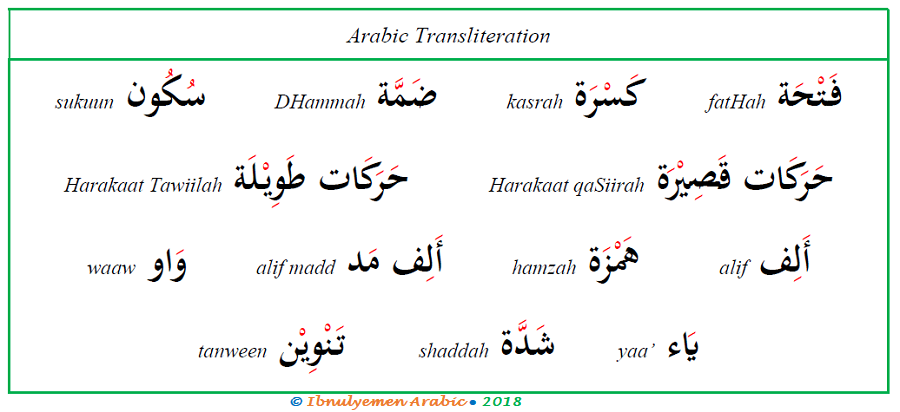Translation of Arabic letters is not recommended. However, in the initial stages of learning, using transliteration is inevitable and sometime useful. It facilitates transition from the pure beginner stage to the upper-beginner stage; plus, it speeds up learning. This lesson presents the actual pronunciation of Arabic sounds in English sounds, i.e. transliterating Arabic sounds into the corresponding English ones. Some Arabic sounds does not exist in English, so a combination of English sounds is used. These sounds are roughly close to Arabic sounds.

In the above table, you can see how the common sound-related terms covered in the first few lessons are transliterated into English. This certainly isn’t to encourage you to follow this path of learning, as it turns out to be a hindrance in later stages of learning since there isn’t a uniform system of using them in language books. Therefore, once you are able to read and write Arabic using its scripts, you must avoid using transliteration altogether.
In the list below, you can see how the Arabic diacriticized letters are transliterated into English. This will help learn new linguistic term faster as they are introduced.
| Arabic Transliteration Sounds / Symbols | |||||||
| English sound | Arabic letter | English sound | Arabic letter | English sound | Arabic letter | English sound | Arabic letter |
| l | لْ | T | طْ | dh | ذْ | b | بْ |
| la | لَ | Ta | طَ | dha | ذَ | ba | بَ |
| li | لِ | Ti | طِ | dhi | ذِ | bi | بِ |
| lu | لُ | Tu | طُ | dhu | ذُ | bu | بُ |
| m | مْ | D | ظْ | r | رْ | t | تْ |
| ma | مَ | Da | ظَ | ra | رَ | ta | تَ |
| mi | مِ | Di | ظِ | ri | رِ | ti | تِ |
| mu | مُ | Du | ظُ | ru | رُ | tu | تُ |
| n | نْ | ‘ | عْ | z | زْ | th | ثْ |
| na | نَ | ‘a | عَ | za | زَ | tha | ثَ |
| ni | نِ | ‘i | عِ | zi | زِ | thi | ثِ |
| nu | نُ | ‘u | عُ | zu | زُ | thu | ثُ |
| h | هْـ | gh | غْ | s | سْ | j | جْ |
| ha | هَـ | gha | غَ | sa | سَ | ja | جَ |
| hi | هِـ | ghi | غِ | si | سِ | ji | جِ |
| hu | هُـ | ghu | غُ | su | سُ | ju | جُ |
| w | وْ | f | فْ | sh | شْ | H | حْ |
| wa | وَ | fa | فَ | sha | شَ | Ha | حَ |
| wi | وِ | fi | فِ | shi | شِ | Hi | حِ |
| wu | وُ | fu | فُ | shu | شُ | Hu | حُ |
| y | يْ | q | قْ | S | صْ | kh | خْ |
| ya | يَ | qa | قَ | Sa | صَ | kha | خَ |
| yi | يِ | qi | قِ | Si | صِ | khi | خِ |
| yu | يُ | qu | قُ | Su | صُ | khu | خُ |
| ’ | ءْ | k | كْ | DH | ضْ | d | دْ |
| ’a | أَ | ka | كَ | DHa | ضَ | da | دَ |
| ’i | ـئِـ | ki | كِ | DHi | ضِ | di | دِ |
| ’u | ـؤُ | ku | كُ | DHu | ضُ | du | دُ |
In the next lesson, you will learn about the diacritics in Arabic, namely the short vowels and why they are not written in Modern Standard Arabic.